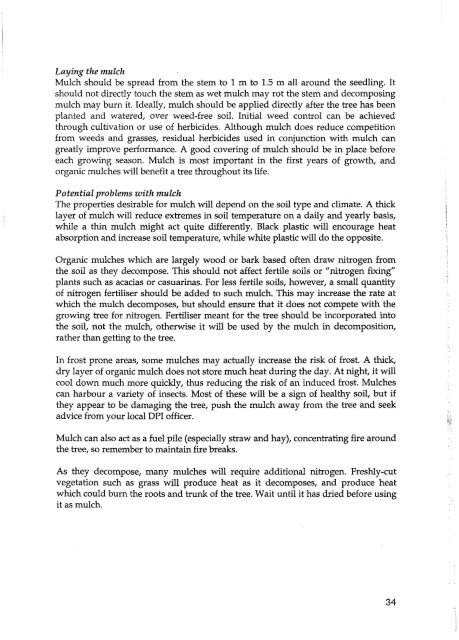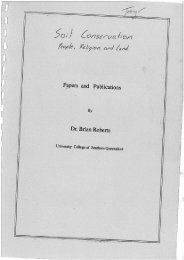western-queensland-gardening-guide.pdf - South West NRM
western-queensland-gardening-guide.pdf - South West NRM
western-queensland-gardening-guide.pdf - South West NRM
Create successful ePaper yourself
Turn your PDF publications into a flip-book with our unique Google optimized e-Paper software.
Laying the mulch<br />
Mulch should be spread from the stem to 1 m to 1.5 m all around the seedling. It<br />
should not directly touch the stem as wet mulch may rot the stem and decomposing<br />
mulch may burn it. Ideally, mulch should be applied directly after the tree has been<br />
planted and watered, over weed-free soil. Initial weed control can be achieved<br />
through cultivation or use of herbicides. Although mulch does reduce competition<br />
from weeds and grasses, residual herbicides used in conjunction with mulch can<br />
greatly improve performance. A good covering of mulch should be in place before<br />
each growing season. Mulch is most important in the first years of growth, and<br />
organic mulches will benefit a tree throughout its life.<br />
Potential pro blems with mulch<br />
The properties desirable for mulch will depend on the soil type and climate. A thick<br />
layer of mulch will reduce extremes in soil temperature on a daily and yearly basis,<br />
while a thin mulch might act quite differently. Black plastic will encourage heat<br />
absorption and increase soil temperature, while white plastic will do the opposite.<br />
Organic mulches which are largely wood or bark based often draw nitrogen from<br />
the soil as they decompose. This should not affect fertile soils or "nitrogen fixing"<br />
plants such as acacias or casuarinas. For less fertile soils, however, a small quantity<br />
of nitrogen fertiliser should be added to such mulch. This may increase the rate at<br />
which the mulch decomposes, but should ensure that it does not compete with the<br />
growing tree for nitrogen. Fertiliser meant for the tree should be incorporated into<br />
the soil, not the mulch, otherwise it will be used by the mulch in decomposition,<br />
rather than getting to the tree.<br />
In frost prone areas, some mulches may actually increase the risk of frost. A thick,<br />
dry layer of organic mulch does not store much heat during the day. At night, it will<br />
cool down much more quickly, thus reducing the risk of an induced frost. Mulches<br />
can harbour a variety of insects. Most of these will be a sign of healthy soil, but if<br />
they appear to be damaging the tree, push the mulch away from the tree and seek<br />
advice from your local DPI officer.<br />
Mulch can also act as a fuel pile (especially straw and hay), concentrating fire around<br />
the tree, so remember to maintain fire breaks.<br />
As they decompose, many mulches will require additional nitrogen. Freshly-cut<br />
vegetation such as grass will produce heat as it decomposes, and produce heat<br />
which could burn the roots and trunk of the tree. Wait until it has dried before using<br />
it as mulch.
















